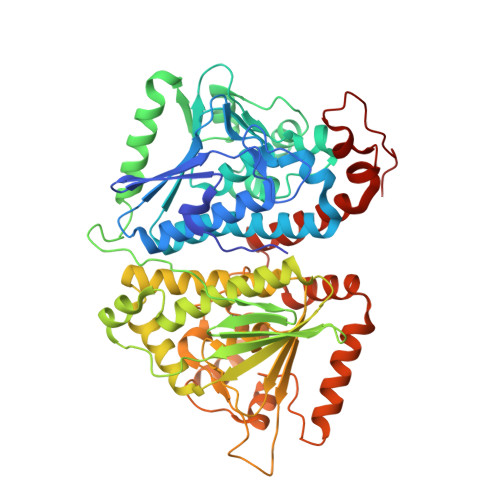Structural and Biophysical Characterization of Boxc from Burkholderia Xenovorans Lb400: A Novel Ring-Cleaving Enzyme in the Crotonase Superfamily.
Bains, J., Leon, R., Boulanger, M.J.(2009) J Biol Chem 284: 16377
- PubMed: 19369256
- DOI: https://doi.org/10.1074/jbc.M900226200
- Primary Citation of Related Structures:
2W3P - PubMed Abstract:
The mineralization of aromatic compounds by microorganisms relies on a structurally and functionally diverse group of ring-cleaving enzymes. The recently discovered benzoate oxidation pathway in Burkholderia xenovorans LB400 encodes a novel such ring-cleaving enzyme, termed BoxC, that catalyzes the conversion of 2,3-dihydro-2,3-dihydroxybenzoyl-CoA to 3,4-dehydroadipyl-CoA without the requirement for molecular oxygen. Sequence analysis indicates that BoxC is a highly divergent member of the crotonase superfamily and nearly double the size of the average superfamily member. The structure of BoxC determined to 1.5 A resolution reveals an intriguing structural demarcation. A highly divergent region in the C terminus probably serves as a structural scaffold for the conserved N terminus that encompasses the active site and, in conjunction with a conserved C-terminal helix, mediates dimer formation. Isothermal titration calorimetry and molecular docking simulations contribute to a detailed view of the active site, resulting in a compelling mechanistic model where a pair of conserved glutamate residues (Glu146 and Glu168) work in tandem to deprotonate the dihydroxylated ring substrate, leading to cleavage. A final deformylation step incorporating a water molecule and Cys111 as a general base completes the formation of 3,4-dehydroadipyl-CoA product. Overall, this study establishes the basis for BoxC as one of the most divergent members of the crotonase superfamily and provides the first structural insight into the mechanism of this novel class of ring-cleaving enzymes.
Organizational Affiliation:
From the Departments of Biochemistry and Microbiology, Victoria, British Columbia V8W 3P6, Canada.
















